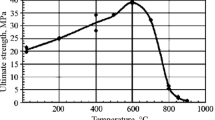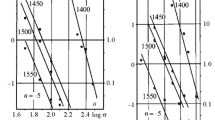Abstract
Special features of the process of high-temperature deformation of refractory ceramics under the action of static mechanical loads, namely, types of deformation curve, functional dependences on the test conditions (temperature, load), and the course of the deformation process, are considered. It is shown that the deformation mechanism in polycrystalline materials is viscous diffusion flow, while in refractories containing a vitreous phase it is viscous flow of the glass.
Similar content being viewed by others
References
V. S. Bakunov, “High-temperature creep of refractory ceramics. Kinetics and the effect of experimental conditions,”Ogneupory, No. 6, 2–8 (1994).
V. S. Bakunov, “High-temperature creep of refractory ceramics. Driving forces and mechanisms,”Ogneupory, No. 7, 12–17 (1994).
V. S. Bakunov, “High-temperature creep of refractory ceramics. Densley sintered single-phase materials,”Ogneupory, No. 8, 5–12 (1994).
V. S. Bakunov, “High-temperature creep of refractory ceramics. Densley sintered multiphase materials,”Ogneupory, No. 9, 2–8 (1994).
V. S. Bakunov, “High-temperature creep of refractory ceramics. Porous materials,”Ogneupory, No. 10, 2–6 (1994).
V. S. Bakunov, “High-temperature creep of refractory ceramics. Refractories,”Ogneupory, No. 11, 2–8 (1994).
V. G. Panteleev and K. S. Ramm, “Prospects of the use of stereology in investigating the structure-property relation in ceramics,”Izv. Akad. Nauk SSSR, Neorganicheskie Materialy,22(12), 1942–1952 (1986).
M. F. Ashby, “A first report on deformation-mechanism maps,”Acta Metall.,20(7), 887–897 (1972).
D. N. Poluboyarinov, E. S. Lukin, and E. P. Sysoev, “Investigation of creep and long-term strength of ceramics from aluminomagnesia spinel,”Ogneupory, No. 12, 26–31 (1975).
É. P. Sysoev, E. S. Lukin, and D. N. Poluboyarinov, “Creep and long-term strength of ceramics from magnesium monoxide,”Ogneupory, No. 6, 38–43 (1972).
É. P. Sysoev, E. S. Lukin, and D. N. Poluboyarinov, “Creep and long-term strength of ceramics from aluminum oxide,”Ogneupory, No. 12, 34–37 (1976).
Author information
Authors and Affiliations
Additional information
Translated from Ogneupory, No. 12, pp. 4–7, December, 1994.
Rights and permissions
About this article
Cite this article
Bakunov, V.S. High-temperature creep of refractory ceramics. Distinctive features of the process. Refractories 35, 392–394 (1994). https://doi.org/10.1007/BF02226353
Received:
Issue Date:
DOI: https://doi.org/10.1007/BF02226353




